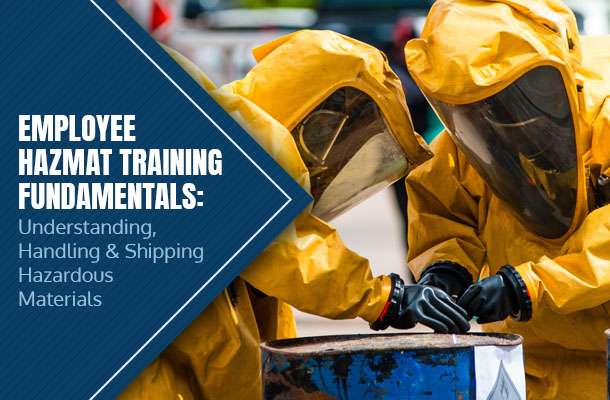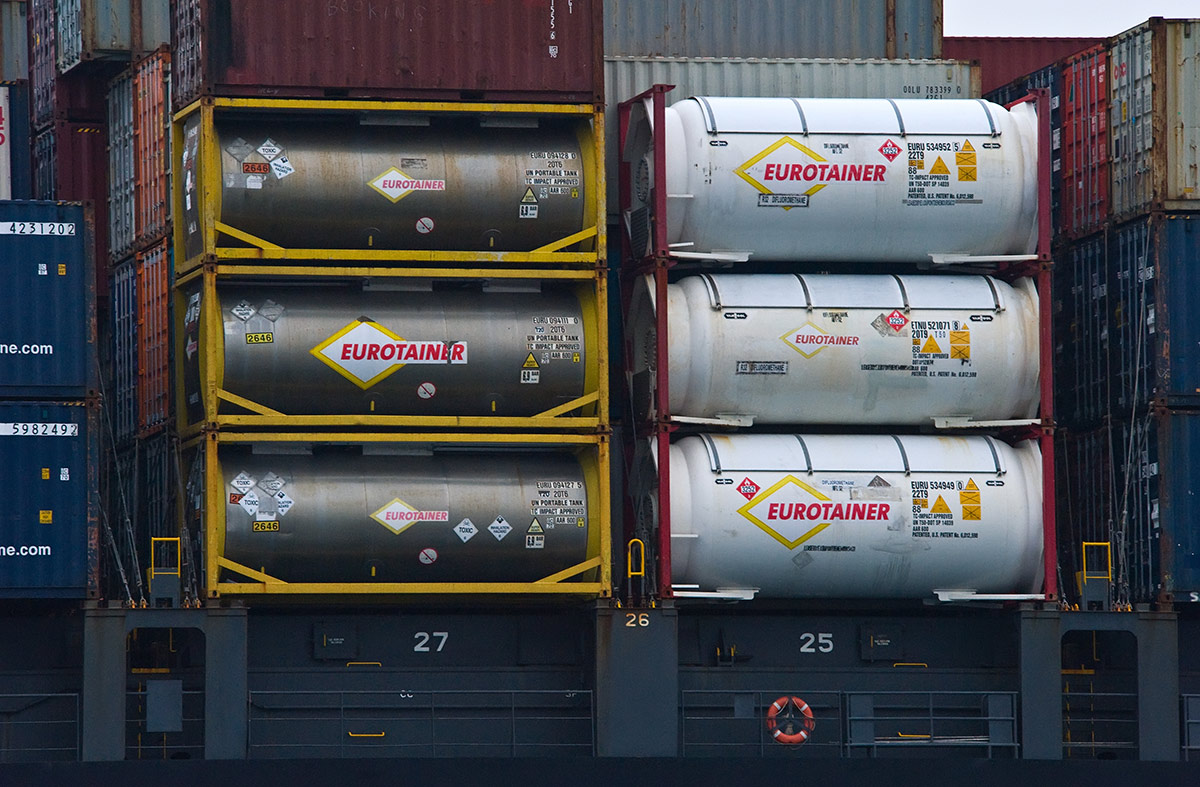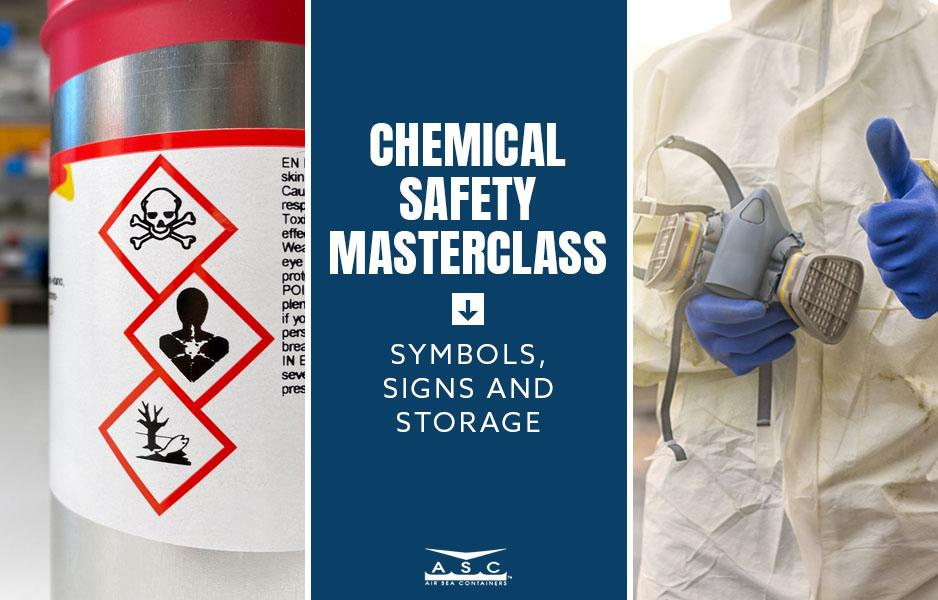Shipping, storing and handling hazardous materials is a high-stakes line of work. The possibilities for environmental damage, property damage, lost productivity and even injury or death can be significant. Rules are strict, fines are high and there are absolutely no shortcuts. Most importantly, to achieve the level of safety that you need, every employee must be on the same page at all times.
However, that doesn’t mean that you can’t make it easier on yourself and your employees by creating a hazmat training program that promotes safety and productivity. At Air Sea Containers, we see ourselves as more than a business selling goods to customers—we see ourselves as your business’s partner in your hazmat safety goals. We’ve been a leader in hazmat shipping solutions since 1991, so we’ve got nearly thirty years of experience in making hazmat shipping safe, reliable and efficient. And, yes—you can have all three!
Here, we’ll go through a basic guide to making sure that your hazmat training practices, storage practices and shipping practices are all up to current standards and in compliance. It’s not always easy, but we pride ourselves on leveraging our experience and our resources to help make it as painless as possible for our customers. There’s much more to know than we could cover in one article—but here are some great places to get started.
Hazardous Materials Categories: An Introduction
A big part of hazmat safety practices is understanding the exact nature of the dangers that each type of material poses. That means paying close attention to the wide body of information available about them, notably the GHS or Globally Harmonized System of Classification and Labeling of Chemicals. This hazmat classification system is used worldwide by freight carriers, shipping industry organizations and government regulators to determine what dangers a particular type of cargo poses and how it should be handled.

The GHS divides hazardous materials into nine basic categories in transport situations:
- Hazard Class 1: Explosives such as TNT, ammunition and fireworks.
- Hazard Class 2: Pressurized gases such as aerosols, fire extinguishers and propane.
- Hazard Class 3: Flammable liquids such as gasoline, fuel oil, paint and many solvents.
- Hazard Class 4: Flammable solids such as powdered metals, sodium batteries and matches.
- Hazard Class 5: Oxidizing substances such as ammonium fertilizers and oxygen generators.
- Hazard Class 6: Toxic and infectious substances such as cyanide, chloroform and medical waste.
- Hazard Class 7: Radioactive substances such as radioactive ores, medical isotopes and depleted uranium.
- Hazard Class 8: Corrosive substances such as strong acids.
- Hazard Class 9: Miscellaneous hazardous substances such as dry ice, lithium-ion batteries and fuel cell engines.
For a more detailed overview of each hazard class, check out our blog on the subject. The GHS also provides a more comprehensive pictogram system for the specific hazards posed by a substance in everyday handling.
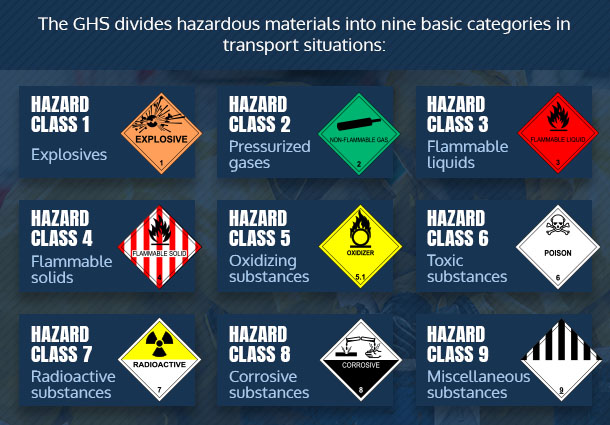
It’s also important to note that there’s a much more specialized level of hazmat information that’s equally vital to be familiar with. The U.S. Department of Transportation’s hazardous materials table is a full list of all materials considered hazardous and their accompanying restrictions. From stowage to quantity to packaging and beyond, you’ll find a detailed and specific guide to safely shipping any hazardous material here.
Training Practices for Hazardous Materials
It’s hard for an employee to handle hazardous materials correctly if they don’t have the right knowledge base, which is why training is so critically important. According to the PHMSA Hazmat Training Handbook, there are five key types of training that any organization that handles hazardous materials must implement:
- General awareness training to facilitate base-level knowledge of hazmat safety.
- Function-specific training for each employee on any hazmat-related functions that they must perform.
- Safety training on how to prevent accidents, respond to emergencies and build a general culture of safety.
- Security awareness training on basic security practices for hazmat transportation.
- In-depth security training on the specific details of your security policies for employees with greater security responsibilities.
PHMSA standards require companies to keep logs on their hazmat training program, including which employees have received which types of training and how recently. Employees must complete their training before beginning work or within 90 days if they are under direct supervision by a trained employee.

In order to get the most out of your employee training, it’s important to lay out the foundation of what you want to accomplish first. Here are some important questions you should ask when establishing a hazmat training program:
- Which employees have job functions that will need hazmat training?
- Which hazmat classes do they need training in?
- Are there employees currently working with materials that they have not received formal training on?
- What hazmat transportation methods do you use?
- Have there been changes in policies, products, management or other areas that will require retraining current employees?
- How will you implement training into your onboarding process and how will you implement it for current employees?
Answering these questions will help you make decisions about how to develop your training program. Once you’ve got a better idea of what your training program needs to accomplish, it’s time to start looking at training methods.
One great training resources that are available for free are the PHMSA Hazardous Materials Training Modules. These online modules cover the basics of hazmat handling that every employee should know, including paperwork, labeling, security and more. They’re not a comprehensive training resource, but they’re a great place to get started. The PHMSA also offers a rolling schedule of webinars and workshops throughout the year that provide in-depth instruction on both general and specialty topics.
For more extensive training, you’ll need to contact a hazmat trainer with certifications from relevant agencies such as the DOT, IMO and IATA. Fortunately, there are many organizations that provide strong, dedicated hazardous materials training programs on demand, and many others that specialize in helping businesses develop theirs.
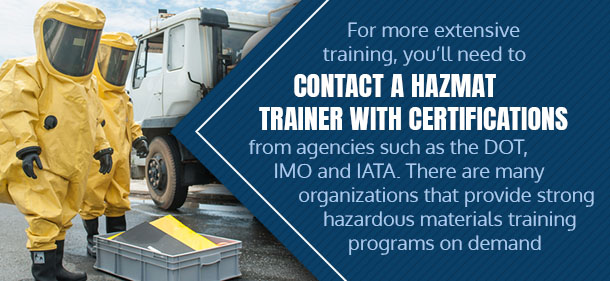
Companies such as Infotrac and Lion Technology offer a range of hazmat training courses, both in-person and online. Make sure that your training program includes a schedule of when employees will need to recertify in their training programs; DOT regulations require that hazmat employees recertify every three years.
While you’re planning out your training program, it’s also important to be aware of some of the basic concepts you’ll need to implement in it. Next up, we’ll address some of the most common areas addressed in hazmat training, as well as some of the best practices that your business will need to be aware of.
Storage Practices for Hazardous Materials
Correct hazmat practices begin at home—or, in this case, in your warehouse or storage facility. Storing hazardous materials correctly and securely is essential for everyday workplace safety, so make sure you’re implementing the following practices into your training program:
- Materials safety data sheets (MSDS) should be your employees’ go-to resource for safe storage and handling of hazardous materials. These are widely available online, so make sure that yours are up to date and provide digital copies as well if possible. For facilities that frequently handle many different hazardous goods, consider purchasing one of the many MSDS applications available so that employees always have the most critical info at their fingertips.
- All hazardous substances should be easily identifiable with hazmat placards and labels, including the manufacturer’s original label when possible.
- Certain types of materials should be stored in safety cabinets, particularly pesticides and flammable materials. Air Sea offers specially designed hazmat lockers for both poisons and flammable goods. They’re designed to offer secure access, protection from accidental contact and hazard containment for leaks or fires.
- If you have hazmat liquids stored in drums, consider investing in spill control pallets. These steel or polyethylene pallets feature a sump inside the pallet to collect hazardous liquids if your barrels spring a leak, preventing a big, hard-to-clean-up mess or even potentially saving lives.
- Make sure hazardous materials are stored securely in a locked area and that employees are properly trained on security procedures. The exact nature of the security you need will depend on the nature of your goods and your location, but it’s a concern you’ll always want to keep in mind.

When combined and integrated into a training program, these practices form a solid foundation that will help your employees store hazardous materials safely. However, for many businesses, storage is only half the story—it’s transportation that creates the most headaches.
Shipping Practices for Hazardous Materials
Hazardous materials transportation is a huge and complex industry and, as you might expect, there are some big challenges involved. It can be a particularly daunting challenge to design a training program if you’re new to hazmat shipping and not sure of the first moves to make.
The first step is to lay a foundation of knowledge by making sure that you and your employees are familiar with the regulations for shipping hazardous materials. Some of the common ones you might need to reference include:
- International Air Transit Association (IATA) Dangerous Goods Code: The main code for anyone shipping dangerous goods by air. Available with workbooks for specific focus areas such as infectious substances, lithium batteries and more.
- International Maritime Dangerous Goods Code: For maritime shippers, this code issued by the International Maritime Association (IMO) is your go-to. You may also need copies of the Safety of Life at Sea (SOLAS) Code or the Marine Pollutants (MARPOL) Code, depending on your circumstances.
- Code of Federal Regulations Title 49: This code, written by the US DOT, regulates freight transportation of hazardous materials in the U.S. We offer both perfect- and spiral-bound editions of the relevant sections.
- Emergency Response Guidebook: This critical document describes hazmat emergency response procedures for first responders, but it’s just as useful to employees working with dangerous goods. The guide describes first aid, fire extinguishing, protective gear and much more. Not only should it be on hand and easily available, but employees should be thoroughly trained in the relevant sections detailing how to respond to an emergency involving any hazardous materials present in your facilities. Pocket-sized copies are available for quick reference.
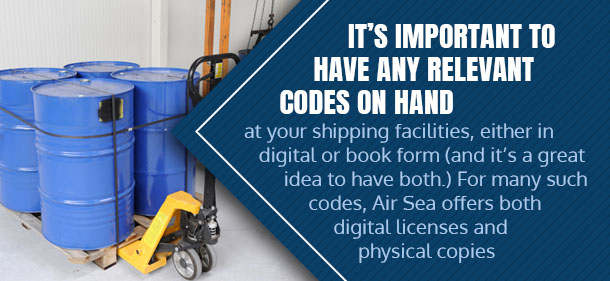
It’s important to have any relevant codes on hand at your shipping facilities, either in digital or book form (and it’s a great idea to have both.) For many such codes, Air Sea offers both digital licenses and physical copies, so that you’ll never have to approach a hazmat shipping question without the correct information at hand. Make sure to also refer back to the full DOT hazmat tables to learn about the specific regulations for shipping your goods.
You’ll need to ensure that employees know how to correctly fill out Dangerous Goods Shipper's Declaration Forms, also available from Air Sea Containers. These forms list hazardous cargo and its categories and provide legal proof that you have correctly declared any and all hazardous goods. They’re important for keeping everyone informed at all stages of the shipping process and help ensure that correct procedures are followed.
Finally, employees will need to know how to coordinate with the freight carriers you use to ship hazardous materials. They’ll need to be aware of many factors, including:
- Some hazardous goods can be sent via USPS, but many cannot. Consult the USPS Hazardous Materials Table to learn what is and what isn’t allowed.
- Any freight carrier or logistics personnel contracted to ship hazardous materials must have a DOT Hazmat Certification.
- Every carrier has its own rules regarding hazmat transportation, so employees will need to look up these regulations ahead of time and work with the carriers to ensure that they’re being followed.

There are no excuses for cutting corners when you’re working with hazardous materials. Every aspect of your operation, from training to shipment to storage, needs to follow best practices and be optimized for safety. Fortunately, you and your employees are working with the accumulated knowledge of decades of safe hazmat shipping. There’s always a right way to do it—and the right way is the only way.
Air Sea Containers is proud to help our customers ship their goods the right way, every time. If you’ve got questions on how you can make your hazmat shipping safer and more effective, we’d love to hear from you. Call our hazmat shipping professionals at (866) 596-9448 or contact us online for advice on custom shipping solutions, best practices of hazmat shipping and much more.

